A Decentralized Framework Integrating BIM 5D and Blockchain for Transparent Payment Automation in Construction
Abstract
1. Introduction
2. Literature Review
2.1. Current State of Construction Payment
2.2. BIM 5D Technology
2.3. Blockchain Technology
3. Framework
3.1. Dapp BIM-5D Framework
3.2. BIM and Construction Schedule Data
3.3. Blockchain, Program and Program-Derived Address
3.4. Document Management and Interplanetary File System
4. Prototype Development
4.1. BIM 5D Application
4.2. Document Management
5. Validation
- The participant creates a project and uploads a BIM model file to generate a 3D view and a construction schedule to generate a Gantt chart in the browser. In this prototype, the construction task and project metadata are recorded in an SQL database (in Figure 7A). For instance, the project manager creates a project and funding, and then the client will deposit tokens to fund as per the project contract. After the client finishes the deposit, the participant can upload the BIM and construction schedule.
- The participant selects projects and construction schedules in those projects (in Figure 7B,C). Then, the participant visualizes construction progress via a Gantt chart and a BIM model in a web browser, which helps connect stakeholders. For instance, the participant modifies the task in the Gantt chart, which corresponds with the BIM model via object identifier (OID), and these changes are recorded in the database.
- The prototype retrieves data from a BIM model to offer BIM 5D functionality to participants. In addition, the quantities will be utilized to track payment progress. For instance, the participant can select a task and check qualities via a quantities table (in Figure 7D).
- When a task is completed, the project manager can proceed with the payment via prototype. For instance, the participant can submit the task to the client via blockchain data, which includes the number of tokens, completion time, and task name, for trust and transparency (in Figure 7E).
- In addition, the prototype allows participants to upload document support, such as a construction report or inspection report, for the payment process. The document will be uploaded to IPFS as a folder via Filebase, and then the CID will be recorded to the blockchain. This helps make the document transparent, trustworthy, and secure without modification (in Figure 7E).
- The client will review the submitted payment from the project manager. For instance, the client can visualize the BIM model, construction progress, quantities, and documents. After that, the client can approve the payment, and the prototype will transfer the token to the contractor’s wallet, which is recorded in the blockchain when creating a project (in Figure 7F).
6. Discussion
7. Conclusions
Author Contributions
Funding
Data Availability Statement
Conflicts of Interest
Appendix A. Decentralized Application
- The fund program enables a client to allocate an initial number of tokens for a project, representing a contractual agreement. Following the initial deposit, the client has the ability to make additional deposits but is not permitted to withdraw funds without obtaining permission from other stakeholders. Furthermore, it exercises control over the approval and transfer of the token once the client has given their approval that the task has been completed. Besides that, the contractor can verify the number of tokens in the project fund.
- The document program enables stakeholders to manage both tasks and documents. Once a task is finished on a construction site, the contractor initiates a payment via DApp. The tasks and documents will be recorded on the blockchain for payment purposes, allowing the client to verify the accuracy of this data. It facilitates the establishment of trust, transparency, and security for this information.

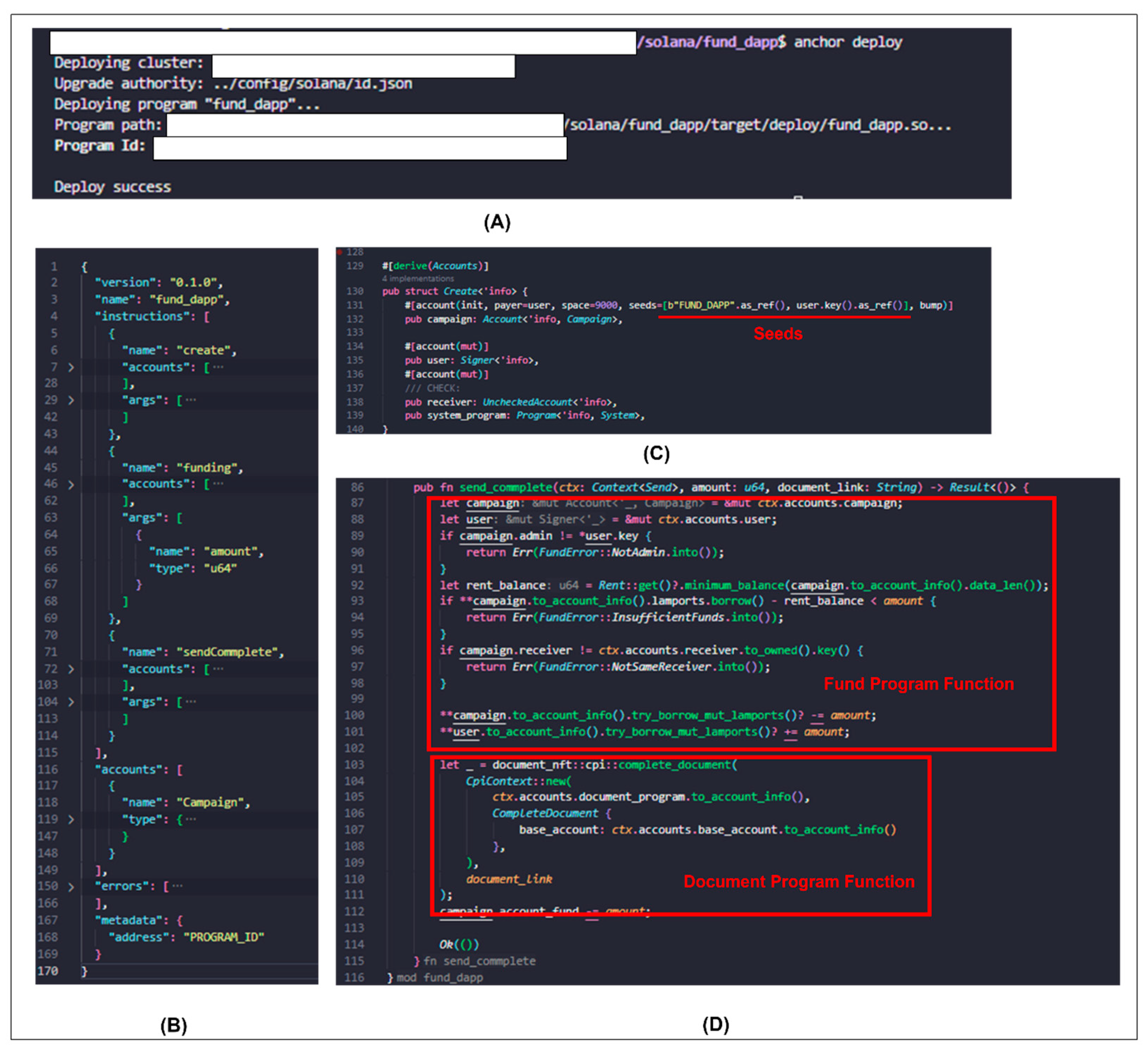
References
- Kamel, M.A.; Bakhoum, E.S.; Marzouk, M.M. A Framework for Smart Construction Contracts Using BIM and Blockchain. Sci. Rep. 2023, 13, 10217. [Google Scholar] [CrossRef]
- Peters, E.; Subar, K.; Martin, H. Late Payment and Nonpayment within the Construction Industry: Causes, Effects, and Solutions. J. Leg. Aff. Disput. Resolut. Eng. Constr. 2019, 11, 04519013. [Google Scholar] [CrossRef]
- Hamledari, H.; Fischer, M. Construction Payment Automation Using Blockchain-Enabled Smart Contracts and Robotic Reality Capture Technologies. Autom. Constr. 2021, 132, 103926. [Google Scholar] [CrossRef]
- Li, J.; Greenwood, D.; Kassem, M. Blockchain in the Built Environment and Construction Industry: A Systematic Review, Conceptual Models and Practical Use Cases. Autom. Constr. 2019, 102, 288–307. [Google Scholar] [CrossRef]
- Liu, H.; Han, S.; Zhu, Z. Blockchain Technology toward Smart Construction: Review and Future Directions. J. Constr. Eng. Manag. 2023, 149, 03123002. [Google Scholar] [CrossRef]
- Pham, H.C.; Tran, S.V.T.; Bao, L. Toward Construction Payment Automation by Integrating BIM and Blockchain Technology. Transp. Res. Procedia 2025, 85, 143–149. [Google Scholar] [CrossRef]
- Ramachandra, T.; Olabode, J.; Rotimi, B. Mitigating Payment Problems in the Construction Industry through Analysis of Construction Payment Disputes. J. Leg. Aff. Disput. Resolut. Eng. Constr. 2014, 7, A4514005. [Google Scholar] [CrossRef]
- Wu, L.; Lu, W.; Xu, J. Blockchain-Based Smart Contract for Smart Payment in Construction: A Focus on the Payment Freezing and Disbursement Cycle. Front. Eng. Manag. 2022, 9, 177–195. [Google Scholar] [CrossRef]
- Tran, S.V.T.; Nguyen, T.L.; Chi, H.L.; Lee, D.; Park, C. Generative Planning for Construction Safety Surveillance Camera Installation in 4D BIM Environment. Autom. Constr. 2022, 134, 104103. [Google Scholar] [CrossRef]
- Tran, S.V.-T.; Lee, D.; Bao, Q.L.; Yoo, T.; Khan, M.; Jo, J.; Park, C. A Human Detection Approach for Intrusion in Hazardous Areas Using 4D-BIM-Based Spatial-Temporal Analysis and Computer Vision. Buildings 2023, 13, 2313. [Google Scholar] [CrossRef]
- Hussain, O.A.I.; Moehler, R.C.; Walsh, S.D.C.; Ahiaga-Dagbui, D.D. Minimizing Cost Overrun in Rail Projects through 5D-BIM: A Conceptual Governance Framework. Buildings 2024, 14, 478. [Google Scholar] [CrossRef]
- Amin Ranjbar, A.; Ansari, R.; Taherkhani, R.; Hosseini, M.R. Developing a Novel Cash Flow Risk Analysis Framework for Construction Projects Based on 5D BIM. J. Build. Eng. 2021, 44, 103341. [Google Scholar] [CrossRef]
- Cassandro, J.; Mirarchi, C.; Pavan, A. A Comprehensive Literature Review of 5D Building Information Modelling Using Latent Dirichlet Allocation Analysis. Constr. Innov. 2025, 25, 331–357. [Google Scholar] [CrossRef]
- Gharaibeh, L.; Matarneh, S.; Lantz, B.; Eriksson, K. Quantifying the Influence of BIM Adoption: An in-Depth Methodology and Practical Case Studies in Construction. Results Eng. 2024, 23, 102555. [Google Scholar] [CrossRef]
- Lee, J.; Moon, H.; Kang, L. Application of Blockchain Technology to Verify Reliability of Life Cycle BIM Model for Civil Engineering Project. Korean J. Constr. Eng. Manag. 2021, 22, 116–124. [Google Scholar] [CrossRef]
- Hamledari, H.; Fischer, M. Role of Blockchain-Enabled Smart Contracts in Automating Construction Progress Payments. J. Leg. Aff. Disput. Resolut. Eng. Constr. 2021, 13, 04520038. [Google Scholar] [CrossRef]
- Lee, S.; Kim, H.; Lee, M.; Kim, J. Development of Evaluation Index for Value Creation of Blockchain Adoption in Real Estate Electronic Transaction System-Based on AHP Analysis. Korean J. Constr. Eng. Manag. 2022, 23, 74–82. [Google Scholar] [CrossRef]
- Sonmez, R.; Ahmadisheykhsarmast, S.; Güngör, A.A. BIM Integrated Smart Contract for Construction Project Progress Payment Administration. Autom. Constr. 2022, 139, 104294. [Google Scholar] [CrossRef]
- Tao, X.; Liu, Y.; Wong, P.K.Y.; Chen, K.; Das, M.; Cheng, J.C.P. Confidentiality-Minded Framework for Blockchain-Based BIM Design Collaboration. Autom. Constr. 2022, 136, 104172. [Google Scholar] [CrossRef]
- Hughes, L.; Dwivedi, Y.K.; Misra, S.K.; Rana, N.P.; Raghavan, V.; Akella, V. Blockchain Research, Practice and Policy: Applications, Benefits, Limitations, Emerging Research Themes and Research Agenda. Int. J. Inf. Manag. 2019, 49, 114–129. [Google Scholar] [CrossRef]
- Lu, W.; Li, X.; Xue, F.; Zhao, R.; Wu, L.; Yeh, A.G.O. Exploring Smart Construction Objects as Blockchain Oracles in Construction Supply Chain Management. Autom. Constr. 2021, 129, 103816. [Google Scholar] [CrossRef]
- Perera, S.; Nanayakkara, S.; Rodrigo, M.N.N.; Senaratne, S.; Weinand, R. Blockchain Technology: Is It Hype or Real in the Construction Industry? J. Ind. Inf. Integr. 2020, 17, 100125. [Google Scholar] [CrossRef]
- Ahmadisheykhsarmast, S.; Sonmez, R. A Smart Contract System for Security of Payment of Construction Contracts. Autom. Constr. 2020, 120, 103401. [Google Scholar] [CrossRef]
- Zheng, Z.; Xie, S.; Dai, H.N.; Chen, W.; Chen, X.; Weng, J.; Imran, M. An Overview on Smart Contracts: Challenges, Advances and Platforms. Futur. Gener. Comput. Syst. 2020, 105, 475–491. [Google Scholar] [CrossRef]
- Das, M.; Luo, H.; Cheng, J.C.P. Securing Interim Payments in Construction Projects through a Blockchain-Based Framework. Autom. Constr. 2020, 118, 103284. [Google Scholar] [CrossRef]
- Hargaden, V.; Papakostas, N.; Newell, A.; Khavia, A.; Scanlon, A. The Role of Blockchain Technologies in Construction Engineering Project Management. In Proceedings of the 2019 IEEE International Conference on Engineering, Technology and Innovation (ICE/ITMC 2019), Valbonne, France, 17–19 June 2019. [Google Scholar] [CrossRef]
- Tran, S.V.T.; Pham, H.C.; Le, Q.T.; Lee, U.K. Digital Technologies for Monitoring Hazardous Area Entry in Construction Sites. Autom. Constr. 2025, 177, 106357. [Google Scholar] [CrossRef]
- Tran, S.; Ali, A.K.; Khan, N.; Lee, D.; Park, C. A Framework for Camera Planning in Construction Site Using 4D BIM and VPL. In Proceedings of the International Symposium on Automation and Robotics in Construction, Online, 27–28 October 2020. [Google Scholar]
- Vigneault, M.A.; Boton, C.; Chong, H.Y.; Cooper-Cooke, B. An Innovative Framework of 5D BIM Solutions for Construction Cost Management: A Systematic Review. Arch. Comput. Methods Eng. 2020, 27, 1013–1030. [Google Scholar] [CrossRef]
- Bao, Q.L.; Tran, S.V.T.; Yang, J.; Pedro, A.; Pham, H.C.; Park, C. Token Incentive Framework for Virtual-Reality-Based Construction Safety Training. Autom. Constr. 2024, 158, 105167. [Google Scholar] [CrossRef]
- Yang, J.; Lee, D.; Baek, C.; Park, C.; Lan, B.Q.; Lee, D. Leveraging Blockchain for Scaffolding Work Management in Construction. IEEE Access 2022, 10, 39220–39238. [Google Scholar] [CrossRef]
- Xue, F.; Lu, W. A Semantic Differential Transaction Approach to Minimizing Information Redundancy for BIM and Blockchain Integration. Autom. Constr. 2020, 118, 103270. [Google Scholar] [CrossRef]
- Hunhevicz, J.J.; Motie, M.; Hall, D.M. Digital Building Twins and Blockchain for Performance-Based (Smart) Contracts. Autom. Constr. 2022, 133, 103981. [Google Scholar] [CrossRef]
- Mahmudnia, D.; Arashpour, M.; Yang, R. Blockchain in Construction Management: Applications, Advantages and Limitations. Autom. Constr. 2022, 140, 104379. [Google Scholar] [CrossRef]
- Elghaish, F.; Abrishami, S.; Hosseini, M.R. Integrated Project Delivery with Blockchain: An Automated Financial System. Autom. Constr. 2020, 114, 103182. [Google Scholar] [CrossRef]
- JavaScript Library|Viewer|Autodesk Platform Services. Available online: https://aps.autodesk.com/en/docs/viewer/v2/reference/javascript/ (accessed on 18 September 2025).
- Learn How the Solana Blockchain Works|Solana. Available online: https://solana.com/docs (accessed on 18 September 2025).
- Filebase|The InterPlanetary Development Platform. Available online: https://filebase.com/ (accessed on 18 September 2025).
- Content-Addressable ARchives (CAR). Available online: https://dasl.ing/car.html (accessed on 18 September 2025).
- Tran, S.V.T.; Yang, J.; Hussain, R.; Khan, N.; Kimito, E.C.; Pedro, A.; Sotani, M.; Lee, U.K.; Park, C. Leveraging Large Language Models for Enhanced Construction Safety Regulation Extraction. J. Inf. Technol. Constr. 2024, 29, 1026–1038. [Google Scholar] [CrossRef]
- Pham, H.C.; Dao, N.N.; Cho, S.; Nguyen, P.T.; Pham-Hang, A.T. Construction Hazard Investigation Leveraging Object Anatomization on an Augmented Photoreality Platform. Appl. Sci. 2019, 9, 4477. [Google Scholar] [CrossRef]
- Bao, L.; Tran, S.V.T.; Nguyen, T.L.; Pham, H.C.; Lee, D.; Park, C. Cross-Platform Virtual Reality for Real-Time Construction Safety Training Using Immersive Web and Industry Foundation Classes. Autom. Constr. 2022, 143, 104565. [Google Scholar] [CrossRef]
- Pham, H.C.; Dao, N.; Pedro, A.; Le, Q.T.; Hussain, R.; Cho, S.; Park, C.S.I.K. Virtual Field Trip for Mobile Construction Safety Education Using 360-Degree Panoramic Virtual Reality. Int. J. Eng. Educ. 2018, 34, 1174–1191. [Google Scholar]
- Le, Q.T.; Pedro, A.; Pham, H.C.; Park, C.S. A Virtual World Based Construction Defect Game for Interactive and Experiential Learning. Int. J. Eng. Educ 2016, 32, 457–467. [Google Scholar]
- Nyato, E.J.; Kimito, E.; Yang, J.; Lee, D.; Lee, D. Blockchain-Integrated Zero-Knowledge Proof System for Privacy-Preserving near-Miss Reporting in Construction Projects. Autom. Constr. 2024, 168, 105825. [Google Scholar] [CrossRef]
- Rocket-Simple, Fast, Type-Safe Web Framework for Rust. Available online: https://rocket.rs/ (accessed on 18 September 2025).

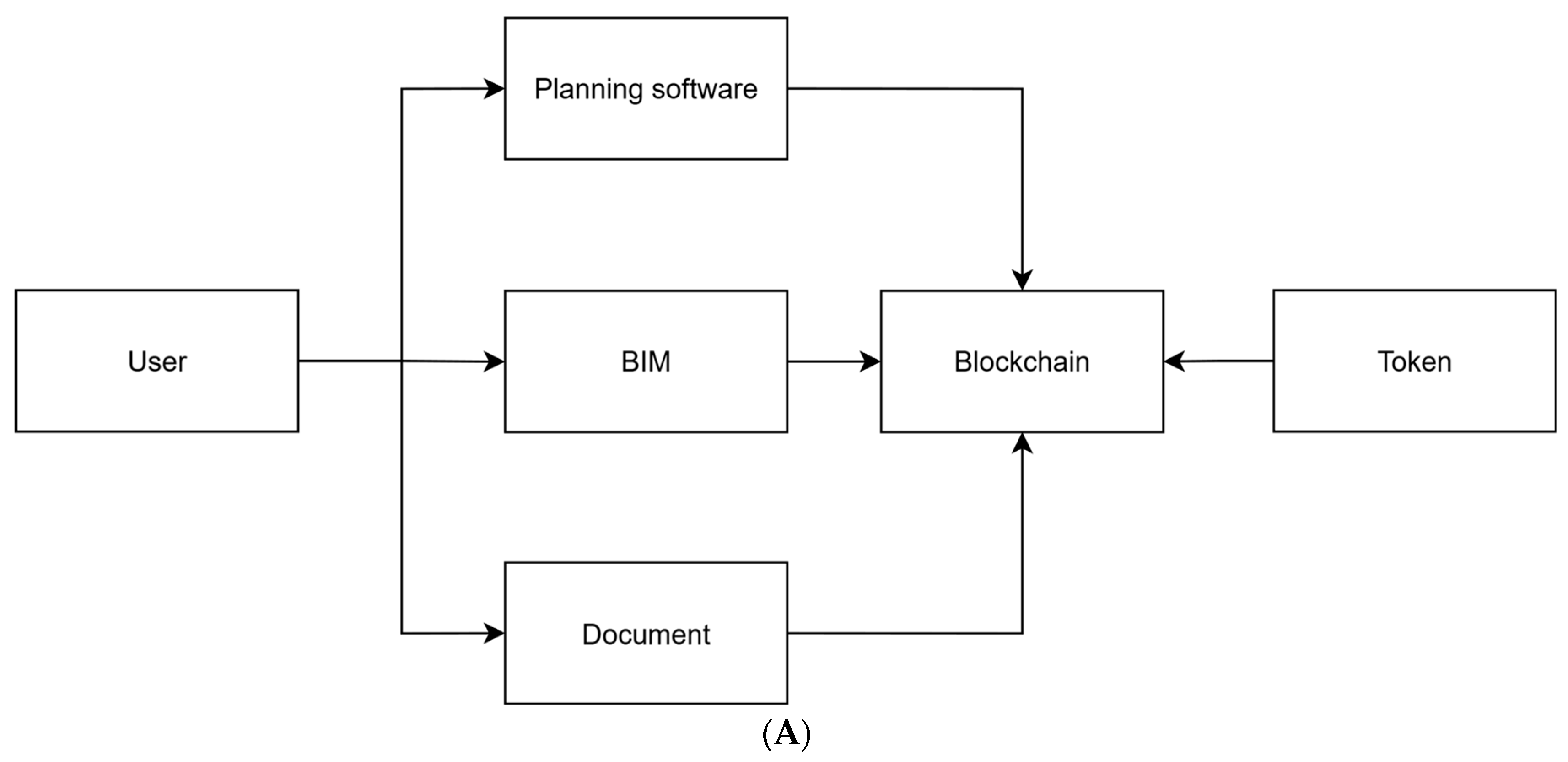
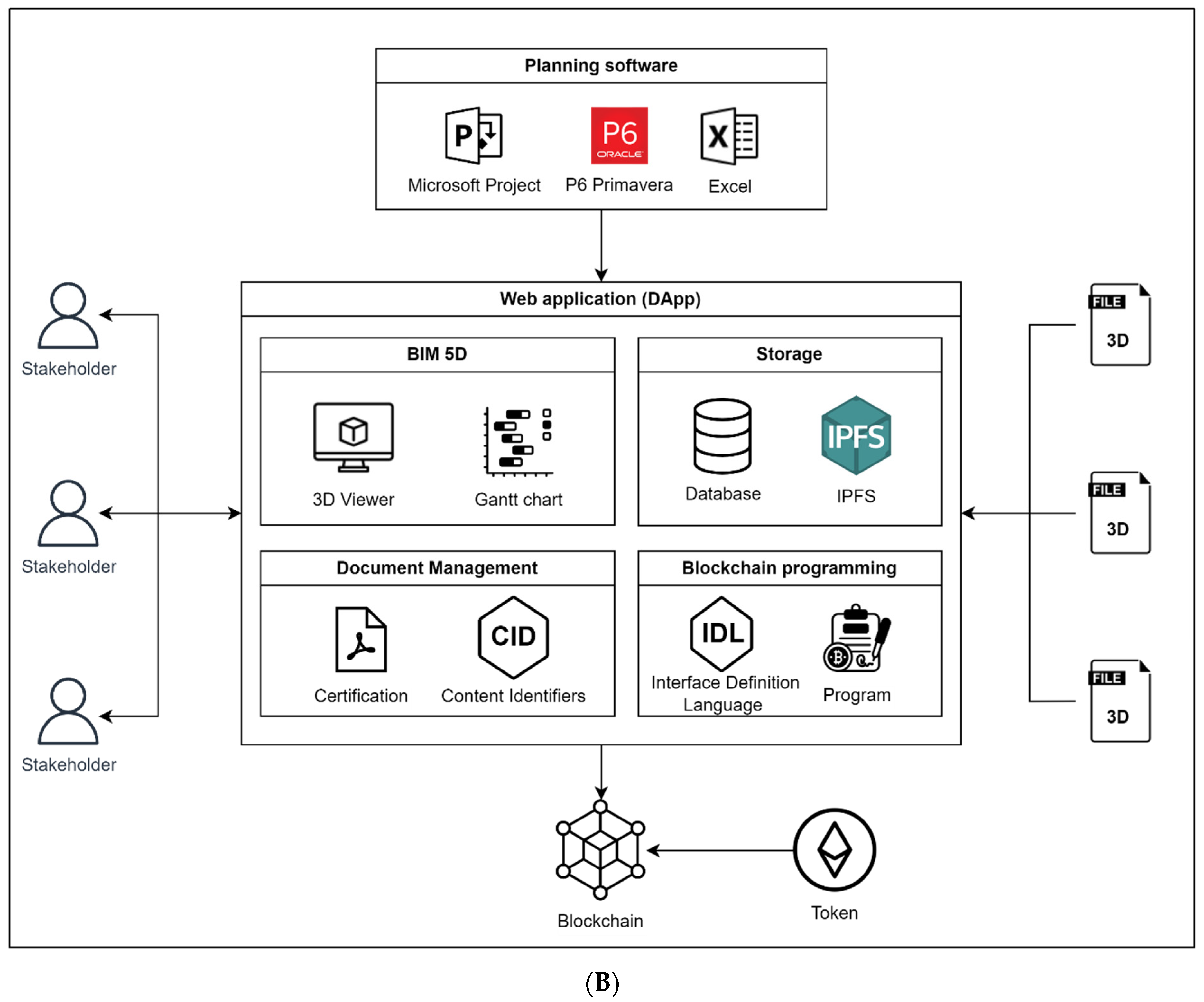
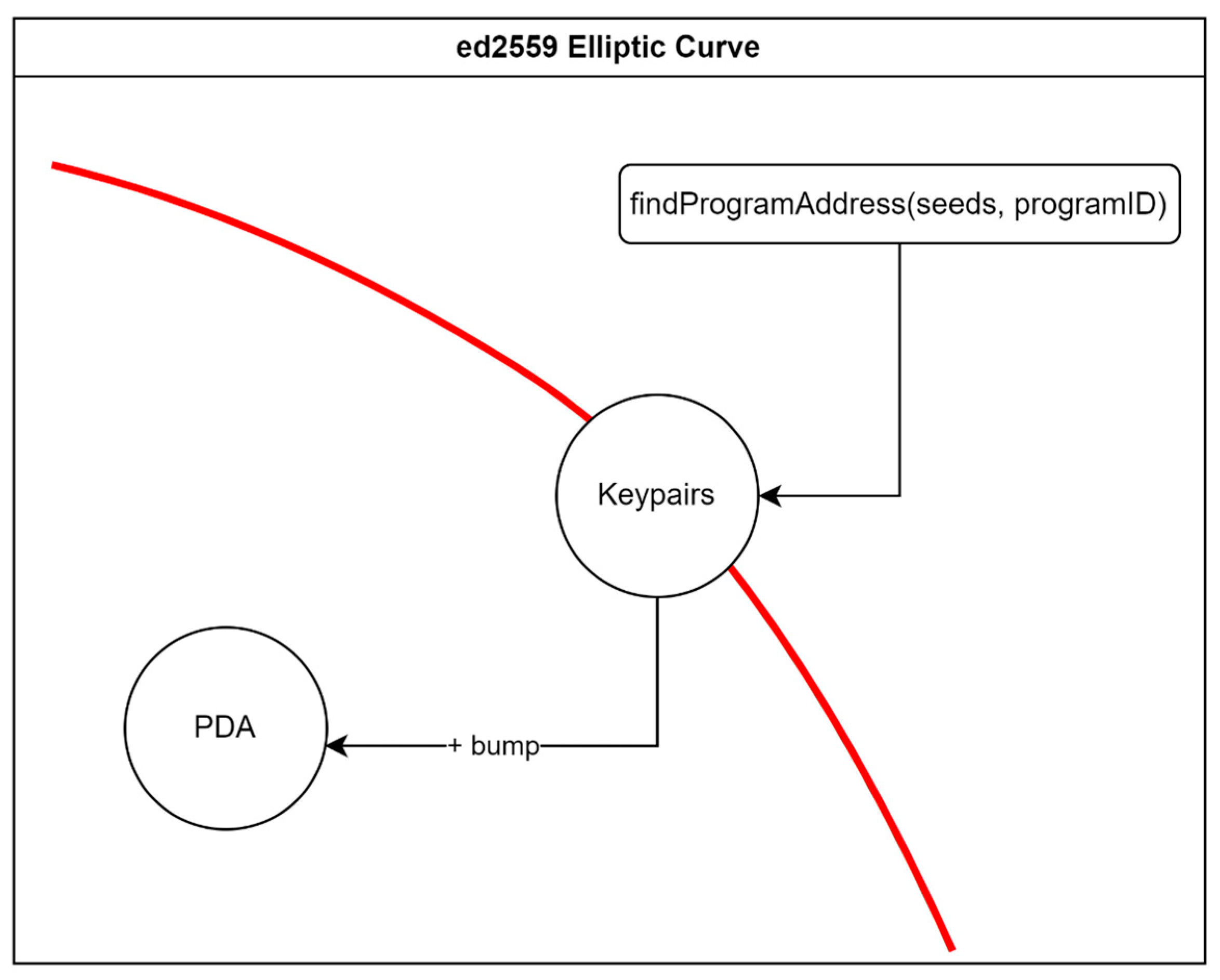
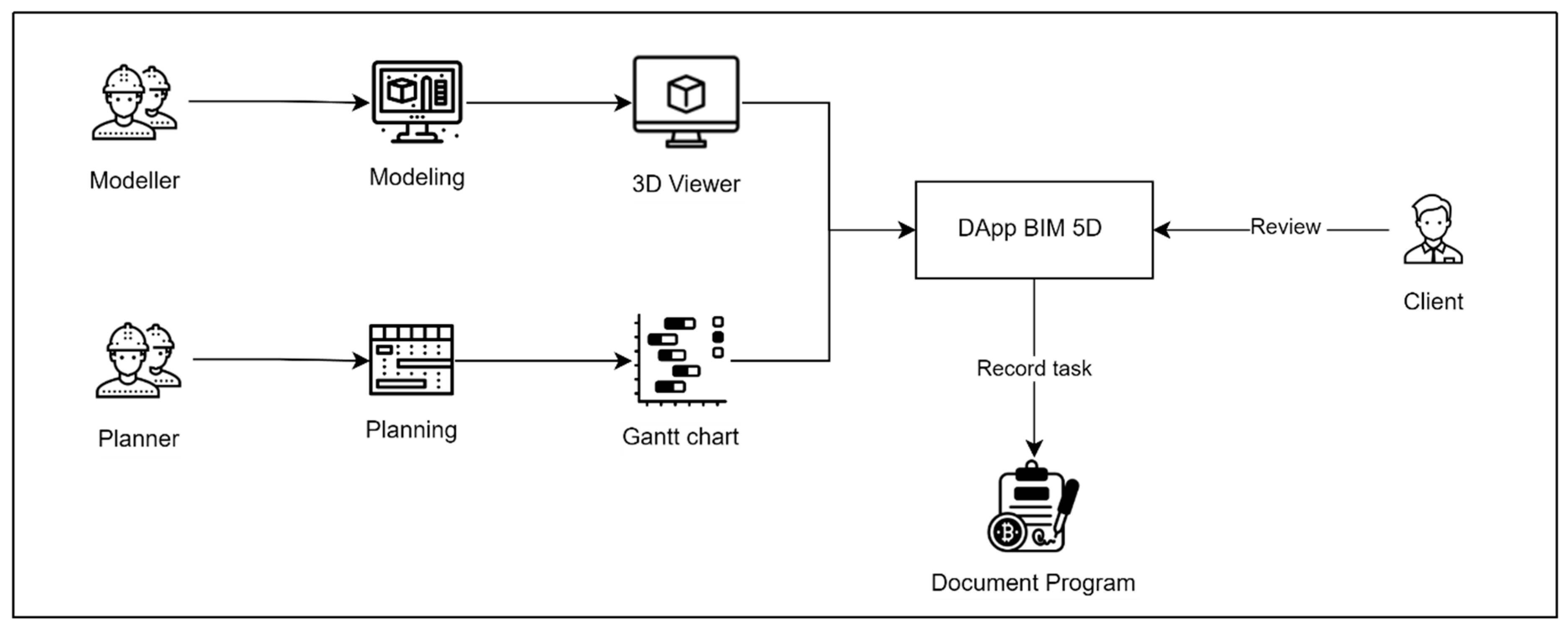


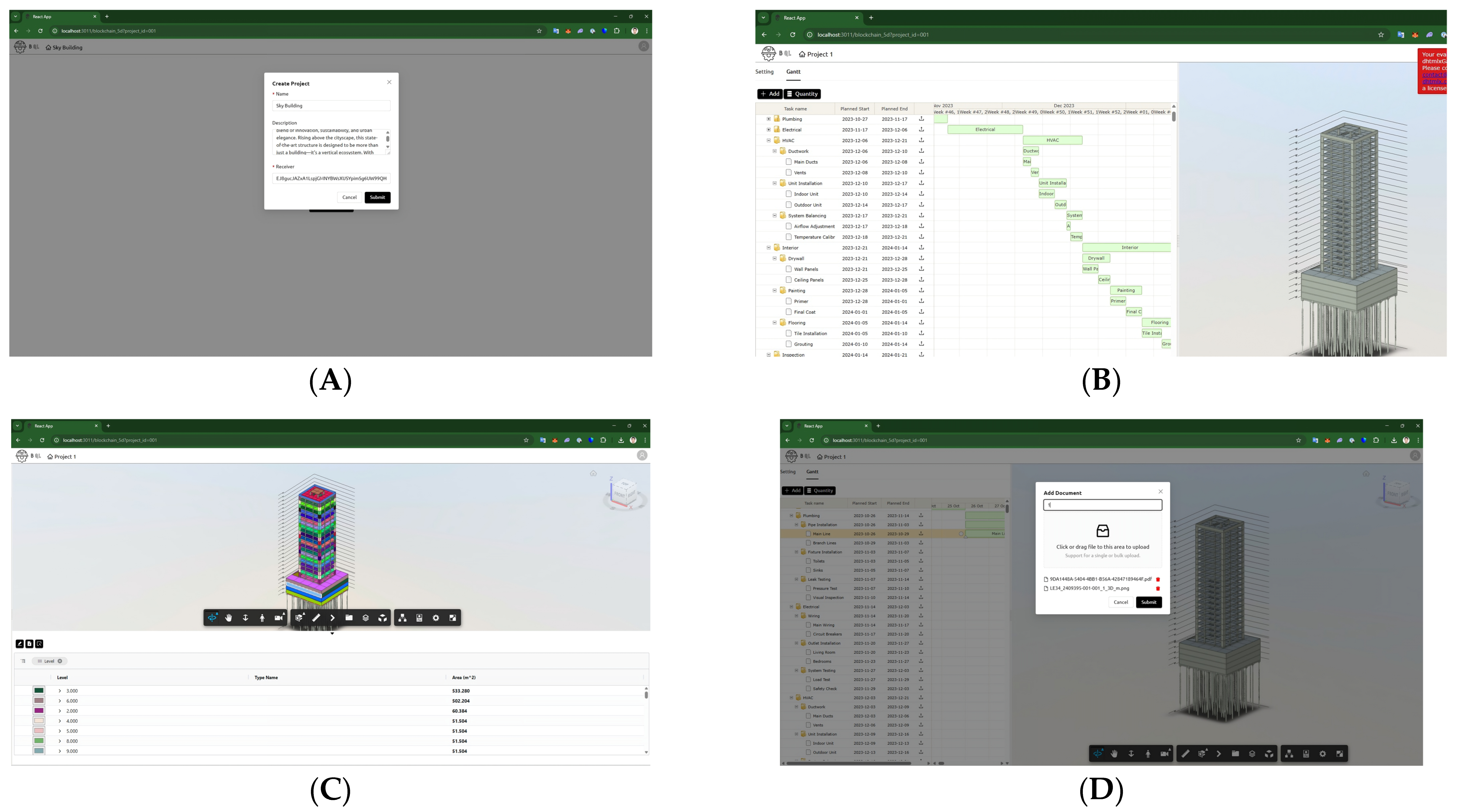


| Reference | Blockchain Type | Integration Focus | Automation Capability | Scalability |
|---|---|---|---|---|
| Hamledari et al. (2021) [3] | Ethereum | Partial (via progress verification) | Smart contract triggers | Low (15 TPS) |
| Sonmez et al. (2022) [18] | Ethereum | 5D BIM linkage | Payment milestones | Limited |
| Elghaish et al. (2020) [35] | Permissioned (Hyperledger) | Cost–schedule coupling | High transparency | Medium |
| Wu et al. (2022) [8] | Permissioned (IoT-BIM) | IoT + BIM data exchange | Automated validation | Medium |
| This study (DB5D) | Solana (public, PoH) | BIM 5D integration | Atomic CPI-based automation | High (thousands TPS) |
| Title | Number of Participants | Years of Experience |
|---|---|---|
| 1. Project manager | 3 | 20–27 |
| 2. Senior BIM manager | 5 | 19–24 |
| 3. MEP manager | 2 | 12–13 |
| 4. Site engineer and BIM engineer | 32 | 3–10 |
| 5. Senior construction students from Ton Duc Thang University | 10 | 0.5–2 |
| Total | 52 |
| Statements | Mean |
|---|---|
| 1. The DB5D prototype is easy to access and experience. | 4.89 |
| 2. The DB5D prototype provides BIM 5D effective. | 4.69 |
| 3. The DB5D prototype provides transparency and trust for documents and payments. | 4.83 |
| 4. The user has a good experience with decentralized cloud storage for documentation. | 4.73 |
| 5. The user wants to apply the method in future projects. | 4.85 |
| 6. The DB5D has the potential for construction payment | 4.82 |
Disclaimer/Publisher’s Note: The statements, opinions and data contained in all publications are solely those of the individual author(s) and contributor(s) and not of MDPI and/or the editor(s). MDPI and/or the editor(s) disclaim responsibility for any injury to people or property resulting from any ideas, methods, instructions or products referred to in the content. |
© 2025 by the authors. Licensee MDPI, Basel, Switzerland. This article is an open access article distributed under the terms and conditions of the Creative Commons Attribution (CC BY) license (https://creativecommons.org/licenses/by/4.0/).
Share and Cite
Pham, H.C.; Tran, S.V.-T.; Bao, Q.L. A Decentralized Framework Integrating BIM 5D and Blockchain for Transparent Payment Automation in Construction. Buildings 2025, 15, 4029. https://doi.org/10.3390/buildings15224029
Pham HC, Tran SV-T, Bao QL. A Decentralized Framework Integrating BIM 5D and Blockchain for Transparent Payment Automation in Construction. Buildings. 2025; 15(22):4029. https://doi.org/10.3390/buildings15224029
Chicago/Turabian StylePham, Hai Chien, Si Van-Tien Tran, and Quy Lan Bao. 2025. "A Decentralized Framework Integrating BIM 5D and Blockchain for Transparent Payment Automation in Construction" Buildings 15, no. 22: 4029. https://doi.org/10.3390/buildings15224029
APA StylePham, H. C., Tran, S. V.-T., & Bao, Q. L. (2025). A Decentralized Framework Integrating BIM 5D and Blockchain for Transparent Payment Automation in Construction. Buildings, 15(22), 4029. https://doi.org/10.3390/buildings15224029









